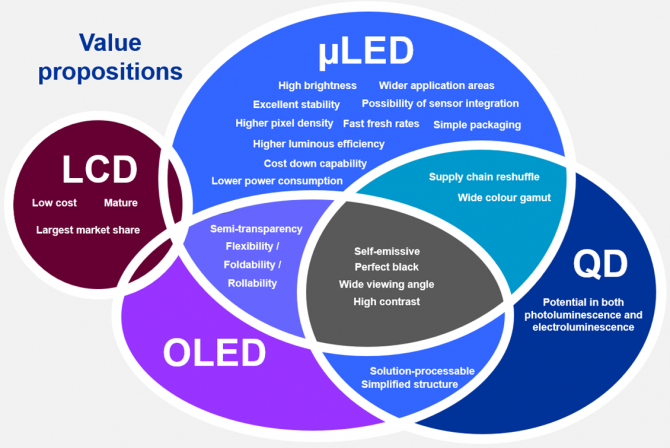
Will micro-LED displays be a threat to OLED displays
By IDTechEx, Cambridge, UK
Electronics Supply Chain displays LED micro-LED OLED opto optoelectronicsIt is widely believed by many that Micro-LED displays are the replacement of OLED displays, IDTechEx reports
With the launch of micro- and mini-LED displays by various OEMs and display vendors, the self-emissive LED-based displays have attracted tremendous attention by both investors and end-users. A selection of examples can be found below:

A selection of Micro- and Mini-LED displays, compiled by IDTechEx.
Micro-LED, believed by many as the next-generation display technology, has been pursued by players of LED, display, OEM, materials and so on. It is also widely believed by many that Micro-LED displays are the replacement of OLED displays, especially in TV applications.
In the LCD regime, LCD manufacturing is shifting to mainland China due to cost competence, new line production efficiency, and industry chain support. Other regions have started to shift away from the LCD business. For instance, Samsung has announced it is ending the LCD business and will focus on its QD LCD & OLED. LG Display has halted its domestic production of LCD panels. Panasonic and JDI are getting out of the LCD business. AUO, Innolux, and a few other Taiwanese companies are slowing down investment in LCD or OLED.
Quantum dot (QD) technology
In the OLED area, OLED panel production is dominated by Korean companies in terms of effective production capacity, technology maturity, upstream materials & equipment, downstream application, and supply chain completeness. For instance, SDC and LGD have supported upstream material and equipment companies, building good ecosystems. For the downstream applications, Samsung’s small/middle-sized OLED panels are firstly supplied to Samsung smartphones, while LGD’s large-sized OLED panels are firstly offered to LG TVs. Their brands can also provide enough attractions and feedbacks. Samsung and LG are dominating small/middle and large-sized OLED panels, respectively.
Another technology existing in the competitive market is quantum dot (QD) technology, mainly using its photoluminescent feature. By applying QD films in the LCD structure, the colour gamut can be significantly improved. QD-based displays are catching up.

Value propositions of various display technologies. Source: IDTechEx.
Micro-LED displays are composed of self-emissive inorganic LEDs, acting as subpixels. These LEDs are usually in the micrometer range, without package nor substrate, and therefore are transferred in a way different from traditional pick & place techniques. Micro-LED displays have value propositions such as wide color gamut, high luminance, low power consumption, excellent stability and long lifetime, wide view angle, high dynamic range, high contrast, fast refresh rate, transparency, seamless connection, and sensor integration capability, etc.
Each technology has its marketing features to attract end-users but from the graph shown below, some of the value propositions can be provided by alternatives such as LCD, OLED and QD, not Micro-LED only. There are some value propositions unique for Micro-LED displays.
Very tiny micro-LEDs are not mature
However, not all the value propositions of Micro-LED displays can be realized based on the current technology maturity and cost expectation, such as low power consumption (the EQEs of very tiny micro-LEDs are low and final device power consumption can be much higher), extremely high resolution (similarly very tiny micro-LEDs are not mature and therefore it is very difficult and/or costly to achieve extremely high-resolution Micro-LED displays), etc. In addition, based on current status some value propositions may not be so significant for specific applications considering much higher cost. One example is the extremely long lifetime for mobile phone applications: Users may change their phone every 2 to 3 years, making the long lifetime less attractive considering the costs.
Therefore, whether Micro-LED displays can replace OLED or not, at least for the short to medium time scale, is a very application-dependent question.
